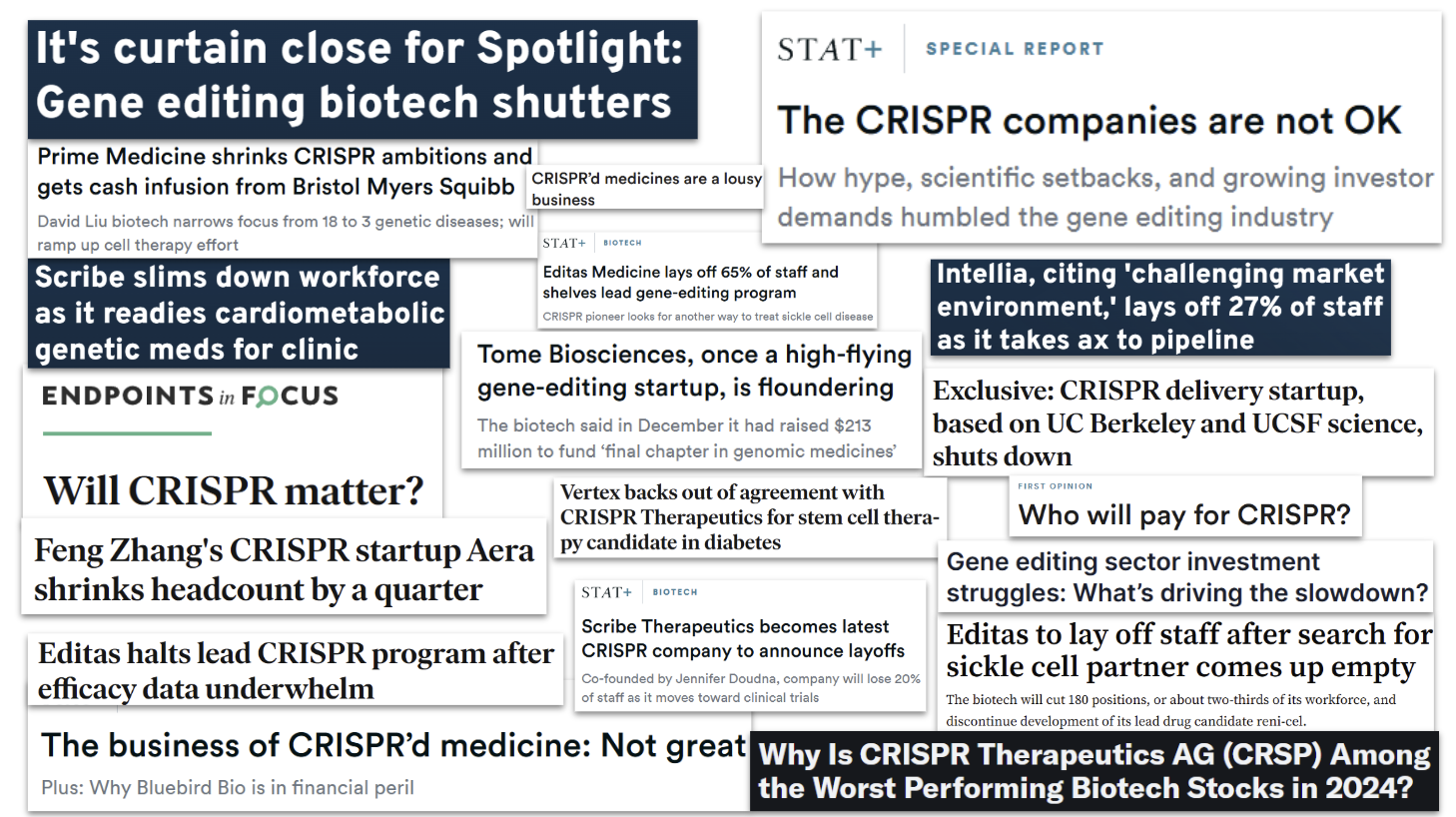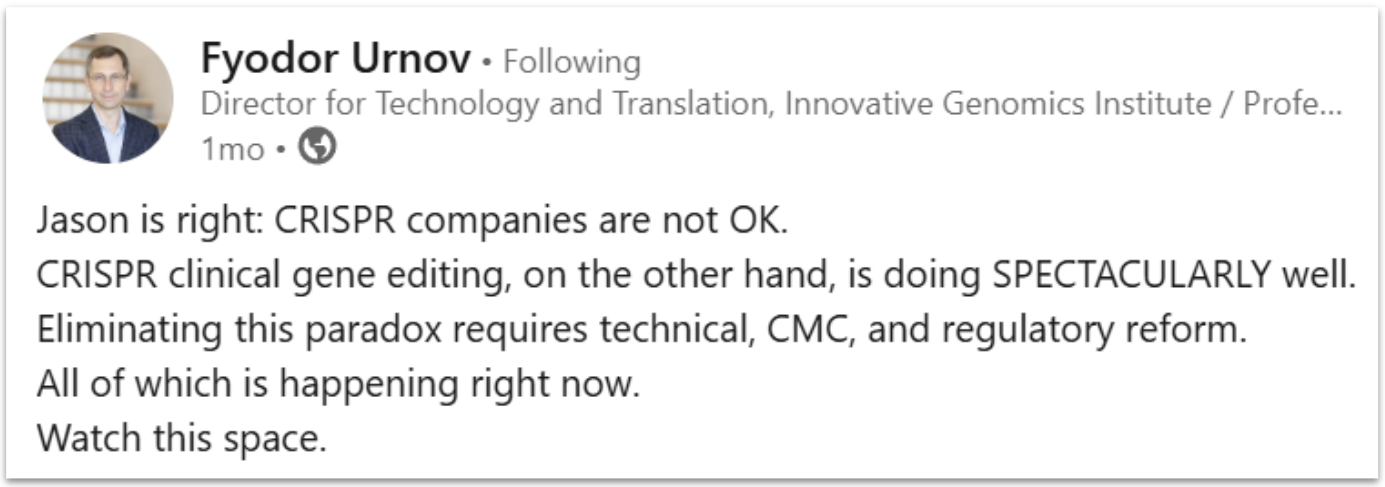When CRISPR burst onto the scene nearly a decade ago, it was hailed as a game-changer for humanity, with headlines buzzing about its potential to cure diseases and build a more sustainable future.
But around two to three years ago, the CRISPR story took a noticeable turn.
A deluge of negative press started bombarding the CRISPR sector: Stock prices for CRISPR companies tanked, layoffs piled up, and some firms shuttered entirely. Even the landmark approval of Casgevy — the first FDA-approved CRISPR therapy — didn’t deliver the knockout punch investors craved. Priced at $2 million, it racked up just $10 million in sales per Vertex’s 2024 filing. Do the math: Not many patients are lining up, at least, not initially. Understandably, this has sparked doubts about the viability of one-time cures as a business model.

A slew of negative press coverage of CRISPR and gene editing over the past few years has dampened the sector.
So what does this mean for CRISPR moving forward? Is the future all downhill from here?
To start, I will acknowledge that these concerns aren’t baseless. If your only goal is a quick return on investment in the next quarter, the red flags are definitely real today. And yes, there have been technical stumbles and instances of money chasing shaky CRISPR companies, which are not only invaluable lessons worth learning from, but also par for the course in any scientific enterprise. Furthermore, I see the current media scrutiny as a net positive in holding the industry accountable to the realities of running a business.
At the same time, however, I take a more optimistic view of CRISPR’s potential. To me, the prevailing “doom-and-gloom” narrative surrounding CRISPR feels overly short-sighted, obsessing over financial fluctuations and investor impatience, when the biotech industry requires a long-term lens. (Those who follow me know my stance on short attention spans in biotech.) More importantly, I’d argue this pessimism misses the very reasons why we’re in the biotech/pharma industry in the first place: to transform lives, not just balance sheets.
I’m more bullish about CRISPR’s future because I believe we’re on the verge of a fundamental shift in healthcare attitudes — one in which people will increasingly seek one-time cures over endless chronic disease management. Various studies and polls already show a small, but growing, public acceptance of CRISPR therapies, signaling a potentially swelling market that could redefine treatment. This isn’t a pipe dream; it’s a trend taking root. As demand rises, CRISPR’s reach will expand beyond rare diseases to tackle common killers such as diabetes or heart disease. This increased scale will eventually drive down costs, thereby transforming today’s affordability complaints into tomorrow’s footnotes.
The science is also catching up fast. The FDA’s approval of Casgevy not only set a critical medical milestone, but also derisked the field, especially for ex vivo applications (editing cells outside the body). Moreover, promising early results from in vivo trials (editing inside patients) have further solidified the potential of the technology for prime time.
Additionally, the number of CRISPR-related research continues to rise year over year. And as researchers become more savvy — particularly with newer gene-editing tools and strategies that offer greater precision and specificity — the clinical applications will evolve to tackle more common diseases effectively, all while potentially slashing long-term R&D costs. Again, for the investors reading this, the market potential is on the horizon.

The exponential growth of CRISPR-related publications on PubMed reflects the field’s rising momentum despite recent skepticism.
Nevertheless, while I’m positive on CRISPR’s future, the age-old challenge of delivery — specifically, how to effectively target CRISPR’s machinery to the right cells — still looms large, or at least the perception of it does. In reality, however, that barrier is starting to show early signs of cracking. New delivery technologies and ultracompact CRISPR systems are beginning to unlock indications beyond the liver, thereby broadening the technology’s scope. What was always historically heralded as an industry bottleneck is now, ironically, a gateway to amplifying CRISPR’s potential to transform lives.
As the technology advances, the industry, itself, is maturing in tandem. It’s without question that early CRISPR companies burned through cash to lay the groundwork. Yet, their lessons are now paying dividends. Today’s startups are becoming leaner, more capital-efficient, and focused on high-impact applications that stretch funding and cash runways even further.
Meanwhile, big pharma is still forging strategic partnerships with CRISPR companies and pouring resources into the field (albeit, at a lower amount when compared to the pre-COVID era). These signals are not tentative bets. They are votes of confidence from industry visionaries who see the same future we do — one in which gene editing isn't just a fancy science experiment or a pie-in-the-sky ideal, but a cornerstone of medicine.
I’ll add one final take from a scientific communications perspective: In today’s CRISPR discourse, we need a smarter, data-driven approach to engage investors, media, drug developers, and the public. That means curbing the trite and oversold promises of gene editing (we’re well beyond the hype phase now) for a more measured assessment on today’s real innovations, which is still incredibly exciting. Patience will be key here, as any cutting-edge therapy class, including CRISPR, faces a long road of wins and setbacks before widespread adoption.
As Fyodor Urnov — a director at the Innovative Genomics Institute and a preeminent voice in CRISPR — aptly stated in response to the ongoing CRISPR drama, “Watch this space.”

Closing thoughts
To those who eat, breathe, and live CRISPR research and drug development everyday, don’t let the “doom-and-gloom” dampen your spirit. It’s a fleeting distraction to the overall mission. Keep your focus on the work, because it’s too vital to surrender to naysayers, and we’ve made too much progress to turn back now.
And for everyone else, let’s not lose sight of the goal: Finding actual cures for patients. Cynics will call this naive. But in a world where patient lives are at stake, having purpose will only fuel our fight for a healthier future.

About the author
John Kang is the Senior Vice President of Public Relations at HDMZ, leveraging his extensive expertise in communications and the life sciences to lead corporate communications strategies for prominent biotech and life science organizations across domestic and international markets.


